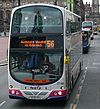Related Research Articles
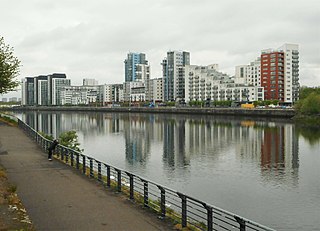
Glasgow is the most populous city in Scotland, the third-most populous city in the United Kingdom, and the 27th-most populous city in Europe. In 2022, it had an estimated population as a defined locality of 632,350 and anchored an urban settlement of 1,028,220. Glasgow became a county in 1893, the city having previously been in the historic county of Lanarkshire, and later growing to also include settlements that were once part of Renfrewshire and Dunbartonshire. It now forms the Glasgow City Council area, one of the 32 council areas of Scotland, and is administered by Glasgow City Council.

Greenock is a town in Inverclyde, Scotland, located in the west central Lowlands of Scotland. The town is currently the administrative centre of Inverclyde Council. It is a former burgh within the historic county of Renfrewshire, and forms part of a contiguous urban area with Gourock to the west and Port Glasgow to the east.

This article deals with the history of the city of Glasgow, Scotland.

The Merchant City, a new name introduced through urban renewal by the Scottish Development Agency and the city council in the 1980s is one part of the metropolitan central area of Glasgow. It commences at George Square and goes eastwards reaching Glasgow Cross, in the centre of Glasgow, Scotland. The eastern fringe of the Merchant City contains part of Glasgow's original medieval street plan, which stretches northwards towards neighbouring Townhead.
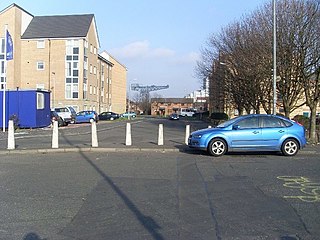
Kinning Park is a southern suburb of Glasgow, Scotland. It was formerly a separate police burgh between 1871 and 1905 before being absorbed by the city. In 1897, it had a population of 14,326.

The Theatre Royal is the oldest theatre in Glasgow and the longest running in Scotland. Located at 282 Hope Street, its front door was originally round the corner in Cowcaddens Street. It currently accommodates 1,541 people and is owned by Scottish Opera. The theatre opened in 1867, adopting the name Theatre Royal two years later. It is also the birthplace of Howard & Wyndham Ltd, owners and managers of theatres in Scotland and England until the 1970s, created by its chairman Baillie Michael Simons in 1895. It was Simons who as a cultural entrepreneur of his day also promoted the building of Kelvingrove Art Gallery and Museum and Glasgow's International Exhibitions of 1888 and 1901.

The High School of Glasgow is a private, co-educational day school in Glasgow, Scotland. The original High School of Glasgow was founded as the choir school of Glasgow Cathedral in around 1124, and is the oldest school in Scotland, and the twelfth oldest in the United Kingdom. On its closure as a selective grammar school by Glasgow City Corporation in 1976, it immediately continued as a co-educational independent school as a result of fundraising activity by its Former Pupil Club and via a merge by the Club with Drewsteignton School. The school maintains a relationship with the Cathedral, where it holds an annual service of commemoration and thanksgiving in September. It counts two British Prime Ministers, two Lords President and the founder of the University of Aberdeen among its alumni.
Thomas Hopkirk (1785–1841) was a Scottish botanist and lithographer.
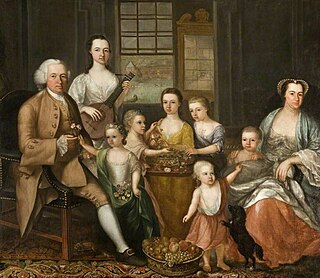
The Tobacco Lords were a group of Scottish merchants active during the Georgian era who made substantial sums of money via their participation in the triangular trade, primarily through dealing in slave-produced tobacco that was grown in the Thirteen Colonies. Concentrated in the port city of Glasgow, these merchants utilised their fortunes, which were also partly made via the direct ownership of slaves, to construct numerous townhouses, churches and other buildings in Scotland.

St. Enoch Square is a public square in Glasgow, Scotland, situated south of the junction of Buchanan Street and Argyle Street, two of the city's busiest shopping streets.
Glasgow City Centre is the central business district of Glasgow, Scotland. Is bounded by Saltmarket, High Street and Castle Street to the east, The River Clyde to the south and the M8 motorway to its west and north. Glasgow City Centre is composed of the areas of Garnethill, Blythswood Hill and Merchant City as well as parts of Cowcaddens, Townhead, Anderston and Calton.

Ingram Street is a major thoroughfare in the city of Glasgow, the largest city in Scotland. The street runs east from Queen Street through the Merchant City until it meets High Street.
William Dunlop was a Covenanter, adventurer, and Principal of the University of Glasgow from 1690 to 1700. An advocate for the use of enslaved labour in America, according to Howe, William Dunlop was the first Presbyterian minister in South Carolina.

Victoria Bridge is a category A listed road bridge spanning the River Clyde in Glasgow, Scotland. Victoria Bridge is the oldest surviving bridge in Glasgow, lying at the foot of Stockwell Street in the city centre.

Colin Dunlop of Carmyle (1706–1777) was an 18th-century Scottish tobacco lord and banker, who served as Lord Provost of Glasgow from 1770 to 1772.
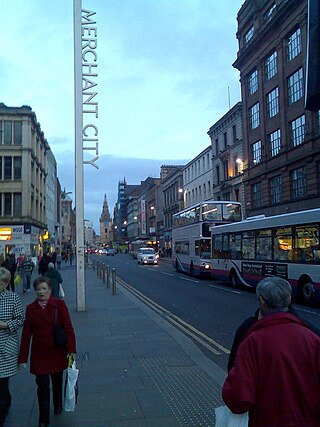
Glassford Street is a major thoroughfare in the city of Glasgow, the largest city in Scotland. The street runs north from the junction of Argyle Street and Trongate through the Merchant City until it meets Ingram Street.
Wilson Street is a thoroughfare in Glasgow, the largest city in Scotland. The street runs east from Virginia Street through the Merchant City until it meets Candleriggs.
Cochrane Street is a major thoroughfare in the city of Glasgow, the largest city in Scotland. The street runs east from the junction of George Square and South Frederick Street through the Merchant City until it meets Montrose Street.
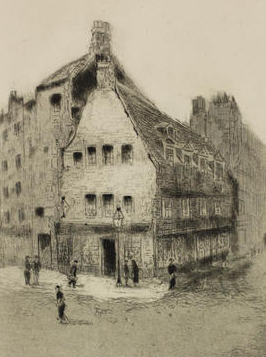
The Ship Bank or more usually Old Ship Bank was an independent bank formed in Glasgow in 1750: Glasgow's first bank.
References
- ↑ Glasgow Street Names and Places. James Muir. William Hodge and Company. 1899.
- ↑ "Every Glasgow street name linked directly to slavery". 7 June 2020.
- ↑ Glasgow Street Names and Places. James Muir. William Hodge and Company. 1899.
- ↑ Glasgow Street Names and Places. James Muir. William Hodge and Company. 1899.
- ↑ "Black Lives Matter: Anti-racism campaigners rename streets across Glasgow".
- ↑ Liam O'Hare (6 June 2020). ""Also includes Joseph Knight Street, a man captured into the slave trade, who fought for his freedom through escaping his Scottish 'master' and winning a court judgement which set the principle against slavery in Scots law…". Archived from the original on 6 June 2020. Retrieved 26 July 2020.
